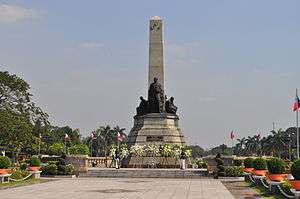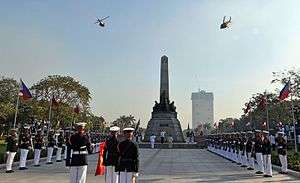Torre de Manila controversy


The ongoing controversy surrounding Torre de Manila, a residential condominium under construction in Manila, Philippines, is related to alleged violations of zoning ordinances by DMCI Homes, the owner of the building, and the condominium's negative impact on the country's heritage due to its supposed visual pollution to the backdrop of the Rizal Monument.
Issues
Zoning violations
Opponents of the building charge that DMCI Homes violated Manila's zoning laws by seeking to build a 49-story high-rise residential building in an area where only school and government buildings of up to seven floors may be constructed. Furthermore, the local zoning ordinance covering the condominium's lot specifies a maximum floor-to-area ratio (FAR) of 4—that is, the total floor area must not be more than four times the lot area. As designed, Torre de Manila's FAR was 7.79, almost twice the allowed limit.[1]
Before starting the condominium's construction, DMCI was able to obtain a zoning permit from Manila's city planning and development office in June 2012 allowing it to build on a lot in Ermita, Manila and exempting the project from zoning laws.[2] DMCI then proceeded to obtain a building permit the next month upon successful submission of requirements. Manila was then under the administration of former Mayor Alfredo Lim.[1]
On November 26, 2013, several months after Joseph Estrada took over as city mayor, the city's council issued a unanimous resolution suspending the project's building permit and halting construction.[3][1] During the Supreme Court hearings in 2015, the city's legal officer admitted that when the zoning permit was issued, DMCI did not actually apply for an exemption.[2] A formal zoning exemption was issued by the Manila Zoning Board of Adjustments and Appeals to DMCI, and construction subsequently resumed in January 2014.[4][1]
Impact on heritage
Much of the opposition to Torre de Manila centered on its intrusion on the visual backdrop of the Rizal Monument—the main monument honoring José Rizal, the country's national hero.
In June 2012, Carlos Celdran, a well-known tour guide in Manila, first initiated a campaign online to protest the planned construction of the condominium stating its negative effect on the monument.[1] The Knights of Rizal, a national civic organization that was formed to uphold the values of Rizal, also started a Change.org petition opposing the project.[2] Critics of the project have nicknamed the condominium the "Terror de Manila" and the "national photobomber".[2][1]
In January 2015, the National Commission for Culture and the Arts (NCCA) issued a cease-and-desist order against the project citing the National Cultural Heritage Act (Republic Act. No. 10066), stating that Torre de Manila "destroys or significantly alters" the monument's view.[2]
Legal proceedings
Senate inquiry
In August 2014, the Senate held an inquiry on the Torre de Manila case.[2]
Supreme Court case
The Knights of Rizal filed a petition with the Supreme Court on September 12, 2014. Citing the Cultural Properties Preservation and Protection Act (Republic Act No. 4846), the National Cultural Heritage Act, and the building's zoning violations, the 26-page petition sought to compel the high court to issue a temporary restraining order (TRO) to suspend the construction, and to ultimately demolish the building. The Knights of Rizal suggested that the Supreme Court should create a "Writ of Pamana" ("heritage") or "Writ of Kasaysayan" ("history") similar to the existing "Writ of Kalikasan" ("nature") as a special legal remedy to enable quicker action on the part of the Supreme Court to protect the country's heritage.[5]
Six months after on June 16, 2015, and voting 8–5 (with 2 associate justices on leave), the Supreme Court partially granted the Knights of Rizal's petition and issued a TRO ordering the suspension of Torre de Manila's construction. The high court also set June 30 as the date of the first oral arguments of the case.[6][7]
References
- 1 2 3 4 5 6 "What Went Before: The saga of Torre de Manila". Philippine Daily Inquirer. 17 June 2015. Retrieved 9 April 2016.
- 1 2 3 4 5 6 Francisco, Katerina (6 September 2015). "TIMELINE: The Torre de Manila case". Rappler. Retrieved 14 April 2016.
- ↑ Ranada, Pia (28 November 2013). "Manila city council suspends Torre de Manila construction". Rappler. Retrieved 14 April 2016.
- ↑ Ranada, Pia (30 January 2014). "Manila OKs Torre de Manila construction". Rappler. Retrieved 14 April 2016.
- ↑ "SC asked to order Torre de Manila demolition". Rappler. 12 September 2014. Retrieved 10 April 2016.
- ↑ "SC halts construction of Torre de Manila". Sun.Star. 16 June 2015. Retrieved 10 April 2016.
- ↑ "SC stops construction of Torre de Manila". Rappler. 16 June 2015. Retrieved 10 April 2016.